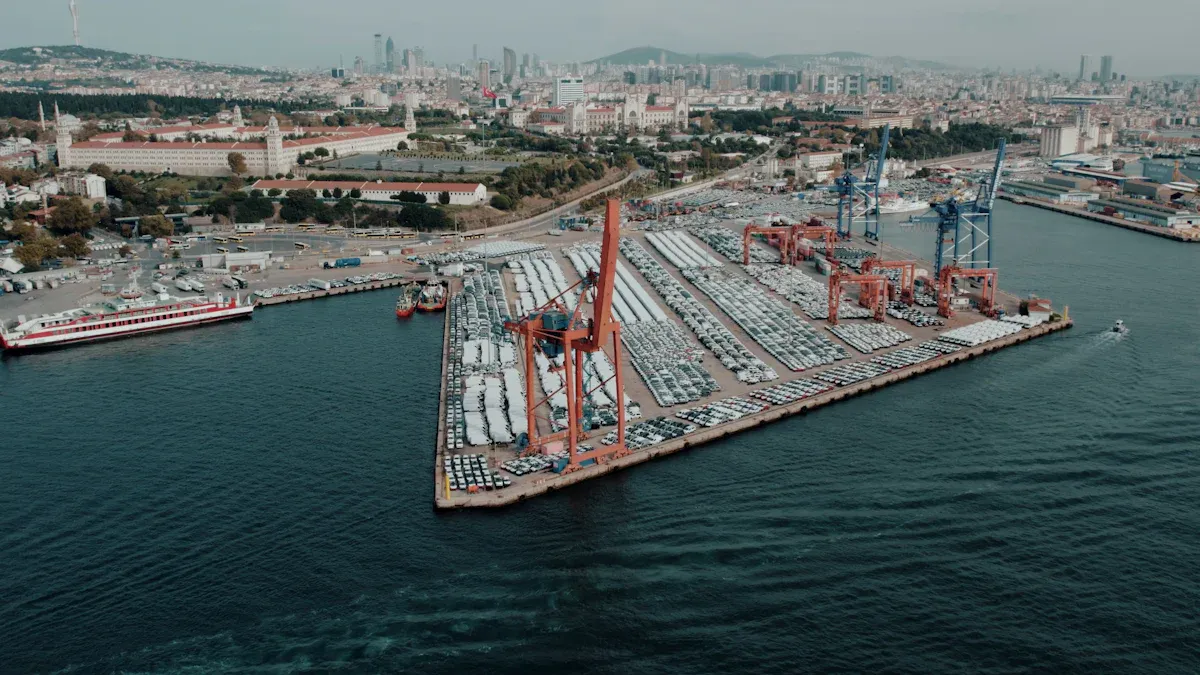US Policy Shifts Drive Manufacturing Reshoring and Domestic Warehouse Expansion

US policy shifts have sparked a significant transformation in manufacturing and logistics. Annualized manufacturing construction spending surged to $237 billion in July 2024, marking an 86% increase from $128 billion two years prior. This growth reflects a strategic pivot as 71% of U.S. CEOs plan to reconfigure supply chains, driving domestic warehouse expansion and reshoring efforts.
Key Takeaways
Bringing manufacturing back to the U.S. helps create jobs. It also reduces the need to depend on other countries for supplies. Companies gain from making products locally and having better quality checks.
The government offers help like tax breaks and money for building roads and factories. Businesses should use these programs to save money and stay competitive.
Using machines and energy-saving tools can cut costs a lot. Companies that try new ideas will do well as manufacturing changes.
Reshoring and Domestic Warehouse Expansion: An Overview

The role of domestic warehouses in reshoring strategies
Domestic warehouses are integral to reshoring strategies, enabling companies to optimize supply chains and meet consumer demands efficiently. By transitioning to localized warehousing models, businesses can reduce shipping costs, improve delivery times, and enhance operational resilience. Over the past six years, approximately 240,000 manufacturing jobs have been reshored, supported by investments in domestic warehousing and infrastructure. Local sourcing through these facilities also offers cost savings of 20-30% compared to offshore production, making it a strategic choice for industries aiming to remain competitive.
US Policy Shifts Driving Reshoring and Warehouse Growth
Trade tariffs and their influence on global supply chains
Trade tariffs have significantly reshaped global supply chains, compelling companies to reconsider their sourcing and manufacturing strategies. Between 2017 and 2019, firms targeted by tariffs experienced a 17% shift in their overall supply chain strategies compared to non-targeted peers. The automobile sector, in particular, saw a 37% disruption in its supply chain structures. Many businesses diversified their supplier base, reducing reliance on single-country suppliers, especially from China. This shift also redirected capital flows to alternative regions like Mexico and Vietnam, further emphasizing the transformative impact of tariffs on global trade dynamics.
Metric | Value | Description |
|---|---|---|
Overall Supply Chain Strategy Change | 17% | Change in strategy for firms targeted by tariffs from 2017 to 2019. |
Automobiles & Components Disruption | 37% | Significant supply chain shifts in the automobile sector due to tariffs. |
Supplier Diversification | N/A | Reduced reliance on single-country suppliers, particularly from China. |
Capital Flow Redistribution | N/A | Investments redirected to regions like Mexico and Vietnam. |
Government incentives for domestic manufacturing and infrastructure
Government incentives have played a pivotal role in driving reshoring and domestic warehouse expansion. Federal initiatives, such as the Chips and Science Act and the Inflation Reduction Act, have provided substantial support for domestic manufacturing in critical sectors. These policies encourage companies to find domestic suppliers, reducing lead times and enhancing production control. Additionally, they address supply chain challenges by offering strategies to overcome logistical hurdles. By fostering infrastructure growth, these incentives have strengthened the foundation for reshoring efforts and bolstered the U.S. economy.
Note: A white paper highlights that reshoring decisions often hinge on cost reduction and supply chain reliability, underscoring the importance of government-backed incentives.
Energy policies and their impact on operational costs
Energy policies have significantly influenced operational costs in manufacturing and warehousing. Companies implementing energy-efficient systems have reported substantial cost reductions. For instance, automation technologies like AutoStore Robots consume minimal energy, with ten robots using the same electricity as one vacuum cleaner. Real-time data from IoT systems allows businesses to adjust energy usage instantly, enhancing efficiency and reducing waste. Some companies have achieved a 75% decrease in power expenses by adopting energy-efficient automated systems, demonstrating the critical role of energy policies in reshoring strategies.
Key Impacts of Energy Policies:
Reduced operational costs through energy-efficient systems.
Enhanced efficiency with IoT-enabled real-time energy adjustments.
Lower environmental impact and improved sustainability.
Tax reforms and their role in reshoring decisions
Tax reforms have made the U.S. a more attractive destination for multinational companies, encouraging reshoring of foreign operations. These reforms enhance the financial viability of domestic manufacturing by reducing corporate tax burdens and incentivizing investments in local facilities. Over time, this has led to significant reshoring of profits and operations, further strengthening the U.S. economy. By aligning tax policies with reshoring objectives, the government has created a favorable environment for businesses to thrive domestically.
Industry and Supply Chain Impacts of Reshoring

Supply chain diversification and risk mitigation
Reshoring has emerged as a strategic response to mitigate supply chain risks and enhance operational stability. By reducing reliance on foreign suppliers, companies can shield themselves from geopolitical uncertainties and natural disasters. For example, General Motors reshored production from Mexico to Tennessee, minimizing exposure to external disruptions. Similarly, Caterpillar relocated the manufacturing of construction equipment from Japan to Georgia and Texas, achieving faster lead times and improved delivery efficiency.
Research highlights that firms with geographically diverse customer bases face less pressure to reshore during periods of heightened geopolitical risk. This underscores the importance of downstream diversification as a risk mitigation strategy. Additionally, U.S. manufacturers have adjusted their supply chains to reduce dependence on foreign suppliers while maintaining stable supplier bases. These efforts reflect a data-driven approach to reshoring, ensuring resilience against external pressures.
Real estate and infrastructure growth for warehouses
The reshoring movement has fueled significant growth in real estate and infrastructure investments for domestic warehouses. Infrastructure projects, such as new roads, airports, and train stations, have transformed remote areas into attractive locations for warehousing. These developments not only enhance accessibility but also boost property values and create job opportunities. For instance, infrastructure improvements have contributed $2.5 trillion to the U.S. GDP, supported 15 million jobs, and generated $881.4 billion in personal earnings.
Enhanced connectivity has also driven demand for residential and commercial real estate near warehouse hubs. Lifestyle amenities in these areas have further increased property values, attracting businesses and workers alike. This growth underscores the critical role of infrastructure in supporting reshoring and warehouse expansion.
Challenges and Strategies for Reshoring Success
Addressing labor shortages through workforce training
Labor shortages remain a critical challenge for reshoring efforts. In March 2022, the U.S. manufacturing sector reported 860,000 unfilled positions, according to the Labor Department’s JOLT database. Despite competitive wages—entry-level positions at Amazon offer $22 per hour compared to $15 in fast food—manufacturing quits reached 337,000 in February 2022, representing 2.7% of the workforce. Workforce training programs can bridge this gap by equipping employees with the necessary skills. However, a 2020 survey revealed that the average annual training hours per employee were only 27.7, with new hires receiving 42.9 hours.
Tip: Companies can partner with educational institutions to develop reskilling programs, ensuring a steady pipeline of skilled workers.
Managing rising costs with automation and technology
Automation has emerged as a vital tool for managing operational costs. A McKinsey study found that automation can boost productivity by up to 30%, leading to significant cost savings. Additionally, a Deloitte report highlighted that 53% of organizations prioritize automation to reduce expenses while improving quality and speed. Technologies like robotics and IoT systems optimize processes and provide real-time data insights, enabling companies to operate efficiently under financial constraints.
Embracing sustainability in reshoring and warehousing
Sustainability plays a pivotal role in reshoring strategies. Companies adopting eco-friendly practices not only reduce their environmental impact but also enhance their brand reputation. For instance, a study by Martínez-Mora and Merino (2020) demonstrated how eco-friendly technology enabled reshoring in the jeans industry. Similarly, Ashby (2016) highlighted a UK company that reduced its carbon footprint by creating a fully localized supply chain.
Study | Findings |
|---|---|
Martínez-Mora and Merino (2020) | Eco-friendly technology facilitated reshoring in the jeans industry. |
Ashby (2016) | Localized supply chains significantly reduced carbon emissions. |
Public-private collaboration for long-term success
Collaboration between public and private sectors is essential for reshoring success. Governments can provide tax incentives, infrastructure investments, and workforce development programs, while businesses can align their strategies with these initiatives. This partnership fosters innovation, strengthens local economies, and ensures long-term competitiveness in the global market.
Note: Public-private partnerships have proven effective in addressing logistical and financial challenges, creating a robust foundation for reshoring efforts.
The Future of Reshoring and Domestic Warehousing
Emerging trends in reshoring and warehouse technology
Reshoring and warehouse technology are evolving rapidly, driven by advancements in automation and artificial intelligence. Robotics, IoT, and AI are transforming warehouse operations, enabling companies to optimize efficiency and reduce costs. The global warehouse automation market is projected to reach $69 billion by 2025, reflecting the growing demand for these technologies. Rising labor costs in traditional offshore locations, such as China, are further encouraging businesses to relocate operations domestically. Industries like transportation, chemicals, and pharmaceuticals are leading this shift, leveraging technology to enhance productivity.
Companies are also adopting dynamic demand forecasting powered by AI to anticipate market changes. Digital twins, which simulate real-world operations, are being utilized for strategic planning and operational efficiency. These innovations allow businesses to align resources with demand, ensuring agility in a competitive market. As reshoring continues to gain momentum, technology will remain a cornerstone of its success.
Adapting to evolving policies and market demands
Adapting to changing policies and market demands requires strategic planning and investment. Economic incentives, such as tax breaks, promote domestic manufacturing and encourage shorter supply chains. Infrastructure investments streamline transportation, reducing costs and improving efficiency. Companies like Intel and Apple are investing heavily in domestic operations to strengthen local supply chains and meet evolving consumer expectations.
Strategy | Description |
|---|---|
Adapting to Political Changes | Businesses must understand how political shifts affect supply chains and operational strategies. |
Supply Chain Diversification | Companies are shifting production to other regions to mitigate risks associated with U.S.-China trade tensions. |
Investment in Technology | Embracing technology is essential for maintaining competitiveness in a changing market landscape. |
Sustainability Focus | Companies are increasingly prioritizing sustainable practices to meet regulatory and consumer demands. |
Government policies are reshaping supply chains by promoting sustainability and technological innovation. Businesses that align with these policies gain a competitive edge, ensuring long-term success.
Long-term benefits for the U.S. economy and global competitiveness
Reshoring offers significant long-term benefits for the U.S. economy and its global competitiveness. Between 2010 and 2020, over 400,000 jobs returned to the U.S. due to reshoring efforts. In 2022 alone, more than 350,000 jobs were reshored, marking the highest annual number recorded. This trend reflects a strong commitment to enhancing domestic capabilities and reducing reliance on international supply chains.
Economic Driver | Evidence |
|---|---|
Cost Variability | Rising labor costs in countries like China and Vietnam have diminished the cost advantage of offshoring. |
Supply Chain Efficiency | The COVID-19 pandemic highlighted vulnerabilities in global supply chains, making reshoring more appealing. |
Job Creation | Over 400,000 jobs were returned to the U.S. from 2010 to 2020 due to reshoring efforts. |
Technological Advancement | Advances in automation and digitalization have made domestic manufacturing more competitive. |
By embracing reshoring, the U.S. strengthens its economic foundation, creates jobs, and enhances supply chain resilience. These efforts position the nation as a leader in global manufacturing and logistics, ensuring sustained growth and competitiveness.
US policy shifts have catalyzed a resurgence in domestic manufacturing and warehouse expansion. These changes present industries with opportunities to enhance supply chain resilience and operational efficiency. However, challenges like labor shortages and rising costs persist. Companies must embrace innovation and align strategies with evolving policies to sustain growth and global competitiveness.
FAQ
What is reshoring, and why is it important?
Reshoring involves bringing manufacturing back to the U.S. It strengthens the economy by creating jobs, reducing supply chain risks, and boosting domestic production.
How do government policies support reshoring efforts?
Policies like tax reforms and manufacturing incentives encourage companies to relocate operations domestically. These measures reduce costs, enhance infrastructure, and improve supply chain efficiency.
What role does technology play in reshoring and warehousing?
Automation, IoT, and AI optimize warehouse operations, reduce costs, and improve efficiency. These technologies make domestic manufacturing more competitive and sustainable.
See Also
Exploring Benefits of Automation in High-Tech Manufacturing Warehouses
Enhancing Supply Chain Strategies for High-Tech Manufacturing Challenges
Transforming Logistics with AI Innovations in Supply Chains
Discovering JUSDA's Latest Warehousing Solutions for Enhanced Efficiency
Addressing Global Supply Chain Growth Challenges Effectively
